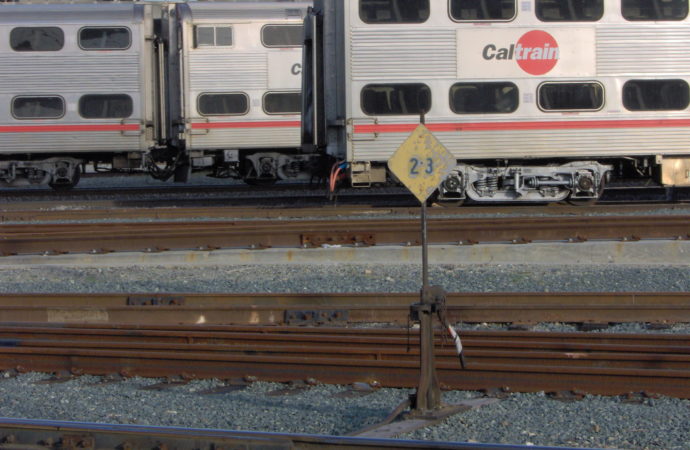Caltrain is a passenger rail service stretching from Santa Clara county to downtown San Francisco, specifically the 4th and King station near the baseball field, not the Transbay Terminal. The Caltrain organization was in line to receive $647 million dollars to help pay for a $2 billion-dollar electrification project. Unfortunately, it was caught in the midst of a change of administrations and mysteriously pushed forward in the most unorthodox way.
No one knows the fate of the grant for sure but for now the Federal Transit Administration (FTA) said it would be considered as part of the President’s budget. Delays are expected because Trump’s staff is not fully appointed yet. News reports say an outline or a “skinny” budget may be out March 14th but there are no promises as to when the full budget will be delivered. These budgets traditionally are subject to great debate among our elected representatives.
Why the grant was halted:
There was a great deal of pressure to stop the grant from going through. On January 24th, 14 Congressional members advised Elaine Chao, the newly appointed Secretary of Transportation of the Federal Railroad Administration (FRA), not to award Caltrain the $647,000 grant. The primary reason was Caltrain’s connection to California’s HSR project. The grant recommendation was rushed through in the final days of the Obama administration. See Congressional letter.
Caltrain’s response:
Here’s Caltrain’s Feb. 17 news release by Caltrain expressing their extreme disappointment in the decision and what might happen next. Though Caltrain has stated in news reports that they had to have the grant by March 1, 2017.
“The contracts that have been awarded to complete the [Peninsula Corridor Electrification Project] require that a Notice to Proceed be issued prior to March 1st. Deferral of the decision to execute the [ Full Funding Grant Agreement] will prevent Caltrain from issuing the notice by this date and may jeopardize the viability of the project itself. Caltrain is evaluating options for maintaining a viable project in the face of uncertainty about the timing of FFGA approval and the question about whether it will be approved at all.”
Something similar happened to the High-Speed Rail project in that delays prevented Tutor Perini (TP) from starting on time and TP received over $50 million in penalty fees and another $13 million for an accelerated schedule.
The link between Caltrain and California High-Speed Rail (HSR)
While Caltrain denied the connection to High-Speed Rail, whether you are a fan of either project, the link is undeniable. There is no question that Caltrain has wanted to electrify their line for decades but it has been out of reach due to finances. But their association with High-Speed Rail (HSR) actually hurt Caltrain. If the deal goes through with HSR, they will share an electrified right of way. Caltrain may have realized their dream to electrify their line by using $713 million High-Speed Rail promised to give them but in exchange they are giving away their future capacity.
Unless of course, Caltrain is betting on the failure of the California High-Speed Rail Project, but only after they receive the money. Perhaps they are hoping the day will never come to pay the piper.
But the catch is the $713 million promised in bond funds was to be used exclusively reserved for high-speed rail development per the bond measure voted on in 2008. Because of this, High-Speed Rail is being sued for violating the state constitution by changing the terms of a bond measure voted for by the public. See the Tos2 or AB1889 lawsuit to understand the issues.
Even the High-Speed Rail’s own, Peer Review Group wrote in a February 2017 letter.”The “blended system” for joint operations by Caltrain and HSRA between San Jose and San Francisco: would not be possible without Caltrain electrification.”
And finally, in a very clear letter, local San Mateo resident, Pat Giorni wrote to the San Jose Mercury News in which she explained Caltrain’s capacity issues and the complex and undeniable link between Caltrain and California’s High-Speed Rail project:
“As evidenced by three Memorandum of Understanding in 2004, 2009, 2013 between the Peninsula Corridor Joint Powers Board (PCJPB) and California High Speed Rail Authority (CHSRA) dedicating the Caltrain Right of Way (ROW) to CHSRA; the 2014 adopted Peninsula Corridor Electrification Project (PCEP) Environmental Impact Report; and despite the Judicial ruling last year, electrification is impossible to assess as a “stand alone” project since the JPB and CHSRA are committed to advancing a blended system concept to accommodate future high-speed rail and modernized Caltrain service by primarily utilizing the existing track configuration.”
“Currently Caltrain operates 5 trains per hour in each direction during the peak morning and evening commute, yet has severely limited itself by placing a 6 train per hour cap on future electrification scheduling in order to accommodate HSR. The addition of only a single train per hour to carry a maximum 650 peak commute hour passengers, capping service at the proscribed level may, in the short term, relieve overcapacity, but fails to meet the full potential of utilizing up to 10 trains per hour which would bring improved train performance, support increased ridership, increase service to existing stations, and re-open service at currently shuttered stations.”
Irregularities in the process:
It was revealed by the LA Times, the grant request found its way to the top of the pile for approval shortly before President Obama left office. But how it was done is the other part of the story. Here’s a quote from Ralph Vartabedian’s article:
“A top Obama Administration executive at the U.S. Department of Transportation approved a $647-million grant for a California rail project in mid-January and less than two weeks later went to work for a Los Angeles-based contractor involved in the project, the Times has learned.”
This unforgivable practice has been repeated over and over again with other DOT personnel. Carolyn Flowers is the third person from the DOT in recent years that has moved into consulting practices associated with rail projects they worked on during their employment with the federal government. Both John Porcari and Roy Kienitz worked on the High-Speed Rail from the federal side, specifically the U.S. Department of Transportation.
Shortly after they left, they went to Parsons Brinckerhoff, the program management company that oversees the entire high-speed rail project in California.
This practice should not be allowed to continue, it’s plain unethical. Perhaps fixing this is in the sight of the new administration since it matches their mantra to “drain the swamp.”
Alternatives or Plan B for Caltrain
Caltrain has a couple of choices, first wait and see if the dollars materialize later in the president’s budget. That could take months to settle. With that delay could come financial penalties for keeping vendors on hold since would have to turn down other work in order to be on stand-by for this project. This happened with the High-Speed Rail project, Tutor Perini charged High-Speed Rail 50 million dollars for not starting on time and another $13 million to expedite the project to make up for lost time.
Alternatively, perhaps it’s time to search for other solutions to modernize Caltrain, perhaps one that offers a great deal of improvement with the added plus of increased capacity for Caltrain’s future growth. Let High-Speed Rail go elsewhere.
Even the transportation organization, GREEN CALTRAIN wrote on February 18th, there might be a Plan B if necessary:
“And what if the administration is dead set on defunding good, job-creating, congestion-relieving transportation projects for political reasons? Here are some brainstorm thoughts on Plan B approaches, in the unwelcome event that we need to go there.
The project could be “value-engineered” – reduced in scope to cost less. A challenge with this approach is that alternatives such as electric locomotives don’t accelerate as fast as the “electric multiple units” that Caltrain has chosen. Because the Caltrain corridor serves cities and stops that are relatively close together, the EMUs will do the best job of serving more stops in less time.”
In reality if Caltrain decoupled from High-Speed Rail it would immediately gain additional capacity of 4 trains per commute hour and it solve the problem that will face Caltrain in the near future. The cost for a new plan, perhaps using alternatives some not even requiring electrification would be far less money.
There is no doubt that California High-Speed Rail is on life support financially and lacking public support. It seems it only lives to spend the remaining money it has and to fund the consultants who are busy churning out environmental studies that will never be used.
Parsons Brinckerhoff manages the High-Speed Rail Project. They also were responsible for building the Big Dig in Boston, noted for its cost over-runs. There was a report written later in 2010 by Michael W. Smith Saint Anselm College in which he recounted a conversation between PB workers when things were going really badly on the Big Dig. PB worried about the very viability of the project. A transcript reveals this:
“Is there a strategy to back ourselves out of this job? Or are we just going to continue to suck on the cow as long as it lives?” the unidentified manager asked, according to the transcript.
“You suck on the cow as long as it’s alive,” another manager replied.
“Absolutely. You’ve got a thousand people on this job,” the first manager said, according to the transcript.
According to this report “the exchange illustrates Bechtel/Parsons Brinckerhoff’s willingness to “put its own welfare and profit ahead of the interests of its client, the Commonwealth and the Turnpike Authority.”
So, for now, back to 2017 and the high-speed rail “cow.” Rail Authority continues to take property they will never build on devastating people’s lives, squandering planning funds and spending precious cap-and-trade dollars meant for projects that will help the environmental pollution not the high-speed rail project that will increase pollution for decades.
After all the spending is finished, it is clear the public will not get a high-speed rail system. A real shame, in fact its despicable. Caltrain should seek Plan B and free itself of the consequences of partnering with high-speed rail.
Insist the Bay Area’s Caltrain system consider modernization without relying on the failed High-Speed Rail funding.
https://petitions.whitehouse.gov/petition/force-san-francisco-bay-areas-caltrain-system-modernize-without-relying-failed-high-speed-rail-funding





